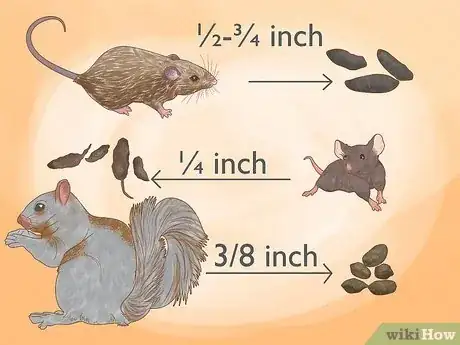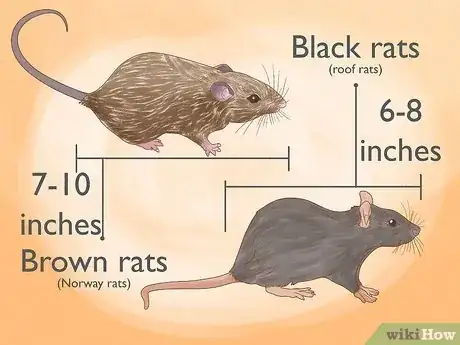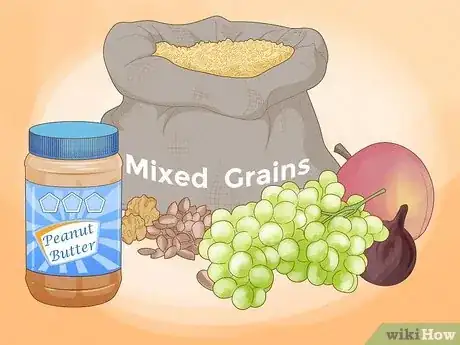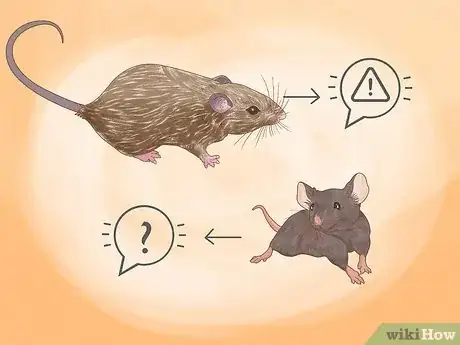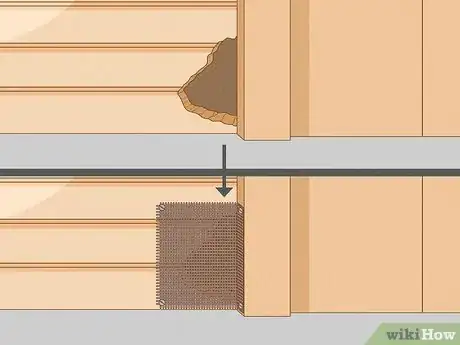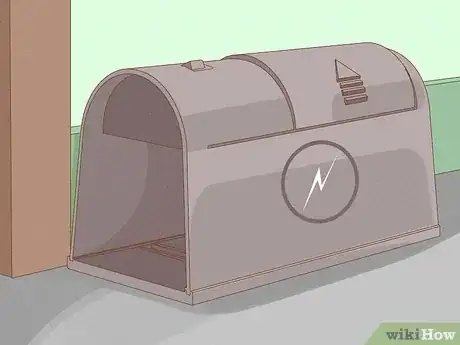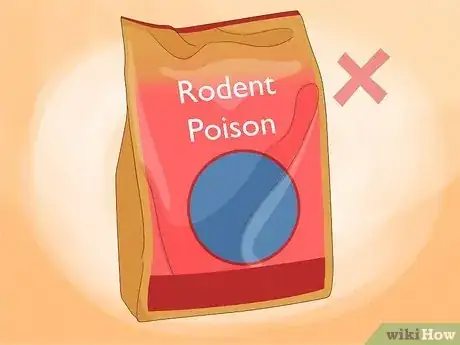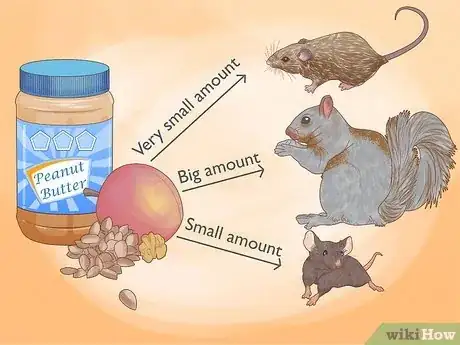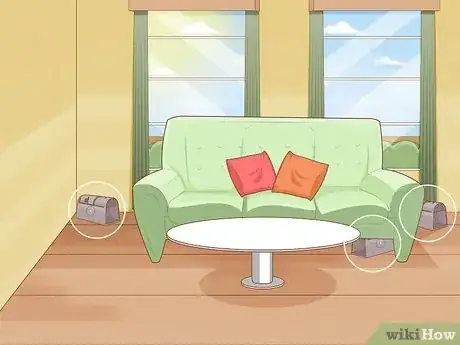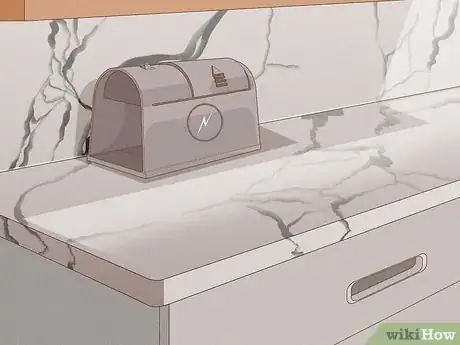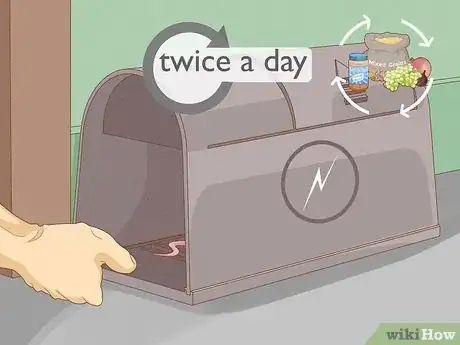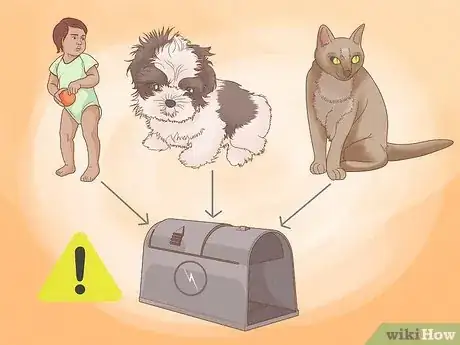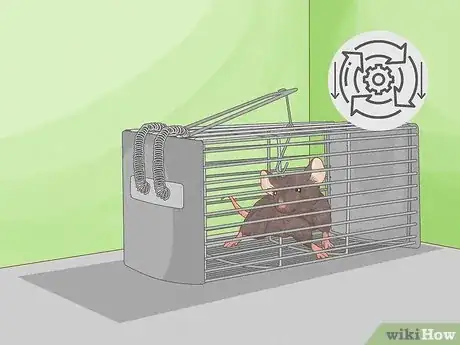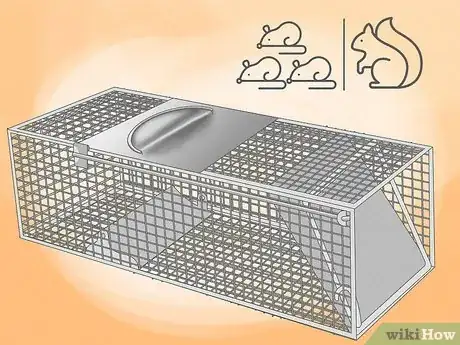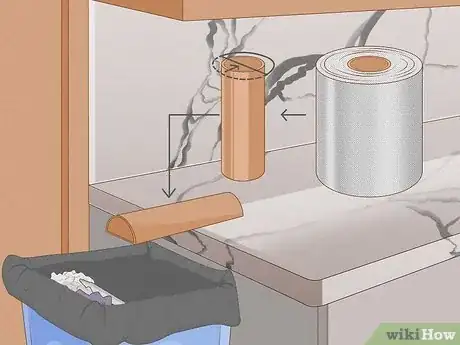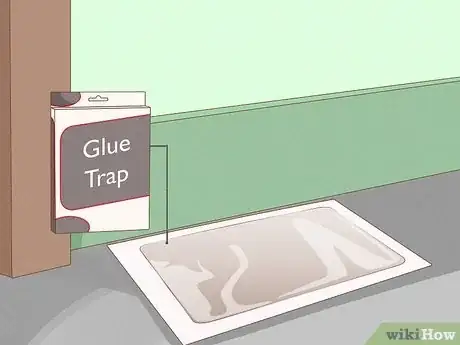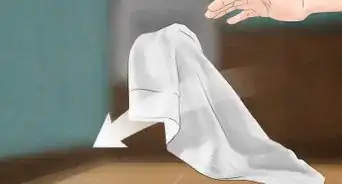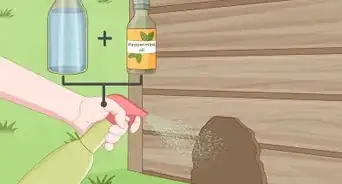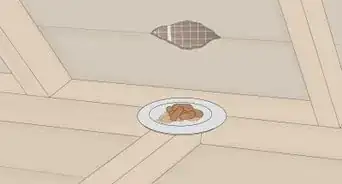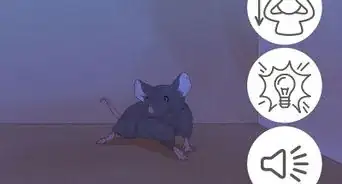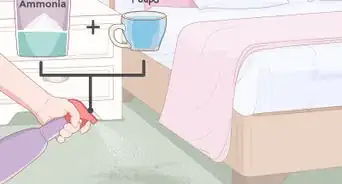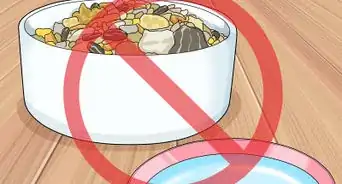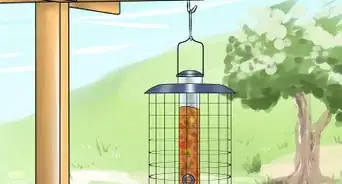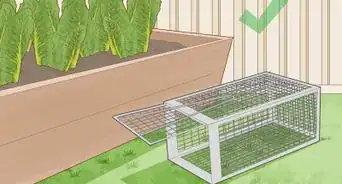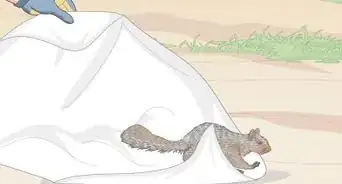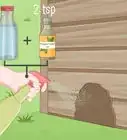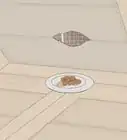This article was co-authored by Hussam Bin Break. Hussam Bin Break is a Certified Commercial Pesticide Applicator and Operations Manager. He and his brother Hussam co-founded Diagno Pest Control in the greater Philadelphia area in 2018, and have since expanded their services to include the New Jersey market. Diagno Pest Control has received Home Advisor's Top Rated and Elite Service Badges for quality of work and customer service.
There are 16 references cited in this article, which can be found at the bottom of the page.
wikiHow marks an article as reader-approved once it receives enough positive feedback. In this case, several readers have written to tell us that this article was helpful to them, earning it our reader-approved status.
This article has been viewed 221,814 times.
Whether long-time squatters or recently-arrived invaders, rodents are particularly impolite house guests. Fortunately, there are proven methods to catch rats, mice, and squirrels with multiple types of traps to help rid your home of any unwelcome rodents. To identify the methods of rodent control that will work for you, first identify what type of rodent is in your home. Then choose the type of trap you feel most comfortable with, and the bait that will be most effective in catching the rodents in your home.
Steps
Identifying Rodents in Your Home
-
1Determine what types of rodents are in your home. Determine rodent type based on the rodent dropping you find. Mice droppings are a ¼ inch long with pointy ends, and rat droppings are ½-¾ inch with relatively rectangular or sausage like shapes.[1] Squirrel droppings are roughly 3/8 inch with rounded edges, and can be recognized by the fact that they lighten in color over time.
-
2Determine which type of rat you’re up against. There are two common types of rats. Brown rats (Norway rats) are particularly common. Their bodies are 7-10 inches long, they have gray-brown fur, and a tail that is shorter than their body. Indoors, they live in basements and lower portions of buildings.[2] Black rats (roof rats) are smaller, with 6-8 inch bodies, darker gray or black fur, and have tails that are longer than their bodies. Indoors, they lives in attics, voids in ceilings, and the upper portions of buildings.[3]Advertisement
-
3Choose bait based on which type of rodent is in your home. Peanut butter is a great option, as it appeals to all types of rodents. Certain types of bait will also work better during certain times of the year.
- For rats and mice, use the kind of food they've been eating in your house as bait. For example, if a rat has been eating your dog's food, use that same dog food to bait the rat into a trap.
- For squirrels, use peanut butter, nuts, grains, seeds, and tender fruits and vegetables.[4]
-
4Recognize behavioral differences between rodents. Aside from favoring certain types of bait, rats and mice have very different temperaments that lead to important behavioral differences. Rats are naturally cautious, while mice tend to be curious.[5] Be aware of seasonal behaviors too. Trap squirrels in late spring and early winter in particular, as this can prevent breeding.[6]
Considering Rodent Control Options
-
1Seal off wherever the rodents are entering your home. One of the most important and effective ways of controlling unwanted rodents is blocking off their entrance point. This will prevent more rodents from getting into your home.
- If you're having trouble locating or closing off the entrance point, reach out to a pest management professional for help.
-
2Consider kill traps. Electronic kill traps are widely considered to be the most effective method of removing mice and rats from your home. They are also safer for non-rodents in your home, and easier to dispose of compared to other kill traps. While they are more expensive, they are the quickest way to rid your home of mice and rats, and are the most humane type of kill trap. (Live traps, however, are the most effective way to get squirrels out of your home.[7] )
- There are kill trap options for trapping mice that you can use without ever seeing or touching a mouse.[8]
-
3Do not use poison. Poison can cause rodents to die in your walls or attic, leading to unpleasant and hard-to-remove aromas. They are also dangerous to pets and children. Considering the relative effectiveness and safety of traps, you do not need to use poison to rid your home of rodents.
- Leave poisons to pest management professionals, who have special, sealed containers that hold the poisons and keep out pets and children.
-
4Use the right amount of bait. Regardless of the type of trap you choose, effective baiting is vital. Depending on the type of trap you’re using and the type of rodent you’re after, different amounts of bait will be ideal.
- For rats, leave traps baited with a small amount of food, but not set, for a few days in a high activity area. This allows rats to become comfortable with the presence of the trap.[9]
- Since mice are more curious, pre-baiting traps is usually unnecessary. Use only a very small amount of bait when trapping mice to ensure the mouse springs the trap.
- For squirrels, use plenty of bait, as you want to lure them fully into a live trap.
-
5Use lots and lots of traps. This is extremely important. Set more traps than you think you need. The number of rodents is almost certainly higher than you think.[10] This is true for both rats and mice. Rodents breed so quickly that professionals recommend that you set a dozen traps for each rodent you see.[11] Continue to trap as long as you see any evidence of rodent activity.[12]
-
6Place traps along walls. Rodents will continue to use established paths, which will almost always be along the base of walls, counters, or similar vertical structure.[13] Place traps perpendicularly against walls where you know rats and mice are traveling. Place traps wherever else you find evidence of rodent presence as well. On pathways you are certain of, place two traps side by side to catch rodents that may jump over the first trap they encounter.
- For squirrels, place traps along the wall in the attic or crawlspace, near the bottom of the trees outside your home, and directly on your roof, especially near trees or power lines that may be routes that squirrels take into your home.[14]
-
7Check your traps frequently. Empty your traps, re-bait them, and reset them as quickly as possible. If a certain bait worked, use it again. Nonetheless, vary the bait from time to time. Change the bait you’re using from time to time to increase a trap’s appeal.[15] For instance, switch from one type of food to another, or, with mice, switch from food to nesting material.
- Check live traps twice a day. Rodents in traps can quickly die from the stress of being trapped.[16]
-
8Take care with pets and children. Keep kids and pets away from traps of all types. This is important to for both your loved ones' safety and for the effectiveness of the traps. Do not touch pets prior to setting trap, as the scent will make rodents avoid the trap.[17]
Using Live Traps for Rodent Control
-
1Be aware that live traps are less effective. While catch and release is undoubtedly the most humane way to rid your home of mice and rats, they will likely try to re-enter your house. If they do not succeed, they will likely die outside.[18]
-
2Consider your live trap options. Use live traps for squirrels. The most common type of live trap is a small cage-like structure with some type of trap door. The company Havahart makes several sizes and models of this type of structure.[21] These are widely considered to be the most effective for trapping squirrels, and can work for rats as well.[22]
- For mice, choose a trap that can hold multiple mice with a rotating trap door. Victor makes several different models that are smaller and designed to catch multiple mice in this way.[23] Since they can catch multiple mice (sometimes as many as a dozen!) without being emptied, they also require less maintenance.
-
3Try a homemade trap. An especially cheap trap option involves using a cardboard tube (such as those used to hold paper towel). Try this if you find evidence of mice on your counters. To try it, flatten one side of the tube so you have a half-circle shaped tunnel. To set your homemade trap:
- Place the tube so that one end hangs off the edge of the counter.
- Place a bucket or garbage can beneath the end of the tube.
- Place a treat at the end of the tube that hangs off the edge of the counter. This will lure mice into the tube. The apparatus – and the mouse – will fall into the receptacle you set up below when the mouse reaches the treat.[24]
- Keep in mind that mice may be able to escape from this trap.
-
4Decide whether glue traps are worth it. Many people consider glue traps inhumane because they cause rodents to die slowly or chew off their own limbs. However, some pest management professionals do use glue traps depending on the situation. You'll need to decide whether the effectiveness of glue traps is worth using them.[25]
Expert Q&A
Did you know you can get expert answers for this article?
Unlock expert answers by supporting wikiHow
-
QuestionHow do I get rid of the rats in my house fast?
 Hussam Bin BreakHussam Bin Break is a Certified Commercial Pesticide Applicator and Operations Manager. He and his brother Hussam co-founded Diagno Pest Control in the greater Philadelphia area in 2018, and have since expanded their services to include the New Jersey market. Diagno Pest Control has received Home Advisor's Top Rated and Elite Service Badges for quality of work and customer service.
Hussam Bin BreakHussam Bin Break is a Certified Commercial Pesticide Applicator and Operations Manager. He and his brother Hussam co-founded Diagno Pest Control in the greater Philadelphia area in 2018, and have since expanded their services to include the New Jersey market. Diagno Pest Control has received Home Advisor's Top Rated and Elite Service Badges for quality of work and customer service.
Pest Control Professional The best way to get rid of rodents is by physically excluding them from your home. Check around the gas and water connections in your kitchen, as well as around any electrical connections. Contractors will often leave small gaps around these that mice can use to enter your home, so you need to seal those off.
The best way to get rid of rodents is by physically excluding them from your home. Check around the gas and water connections in your kitchen, as well as around any electrical connections. Contractors will often leave small gaps around these that mice can use to enter your home, so you need to seal those off.
Warnings
- Do not handle rodents with bare hands. There are parasites and diseases you can contract from rodents.[28]⧼thumbs_response⧽
References
- ↑ http://www.victorpest.com/advice/tips-and-strategies/id-your-problem
- ↑ http://www.victorpest.com/advice/tips-and-strategies/how-to/catch-a-rat
- ↑ http://www.victorpest.com/advice/tips-and-strategies/how-to/catch-a-rat
- ↑ http://www.havahart.com/squirrel-baits
- ↑ http://pestcontrol.about.com/od/identificationofpests/a/The-Difference-Between-Rats-And-Mice.htm
- ↑ http://www.havahart.com/how-to-trap-squirrels
- ↑ http://www.doyourownpestcontrol.com/squirrelcontrol.htm
- ↑ http://www.d-conproducts.com/products/family-high-traffic-rooms/no-view-no-touch-trap/
- ↑ http://www.victorpest.com/advice/tips-and-strategies/how-to/catch-a-rat
- ↑ http://www.doyourownpestcontrol.com/trapping_rats.htm
- ↑ http://www.victorpest.com/advice/tips-and-strategies/how-to/catch-a-mouse
- ↑ http://www.victorpest.com/resources/faqs
- ↑ http://www.victorpest.com/resources/faqs
- ↑ http://www.havahart.com/how-to-trap-squirrels#place
- ↑ http://www.victorpest.com/advice/tips-and-strategies/how-to/catch-a-mouse
- ↑ http://www.wildlife-removal.com/howtotraparat.html
- ↑ http://www.doyourownpestcontrol.com/trapping_rats.htm
- ↑ http://www.wildlifeanimalcontrol.com/mousecatch.html
- ↑ http://www.wildlifeanimalcontrol.com/mousecatch.html
- ↑ http://www.havahart.com/how-to-trap-squirrels
- ↑ http://www.havahart.com/store/animal-traps/rats
- ↑ http://pestkill.org/rodents/squirrels/how-to-trap/
- ↑ http://www.victorpest.com/store/mouse-control/live-traps
- ↑ http://www.wildlifeanimalcontrol.com/mousecatch.html
- ↑ http://www.wildlife-removal.com/howtotraparat.html
- ↑ http://www.victorpest.com/advice/tips-and-strategies/how-to/catch-a-mouse
- ↑ http://www.victorpest.com/advice/tips-and-strategies/how-to/catch-a-rat
- ↑ http://www.doyourownpestcontrol.com/trapping_rats.htm
About This Article
To catch a rodent in your house, fill some electronic kill traps with bait and place them along the bases of your walls and counters, checking them for rodents regularly. If you’d rather not use kill traps, try setting up a few live traps instead. Then, when you catch a rodent, drive a few miles away from your home and release it. Just avoid using poison, which is harmful to pets and children and can cause rodents to die in your walls. To learn how to choose the best bait for rodent traps, scroll down!
